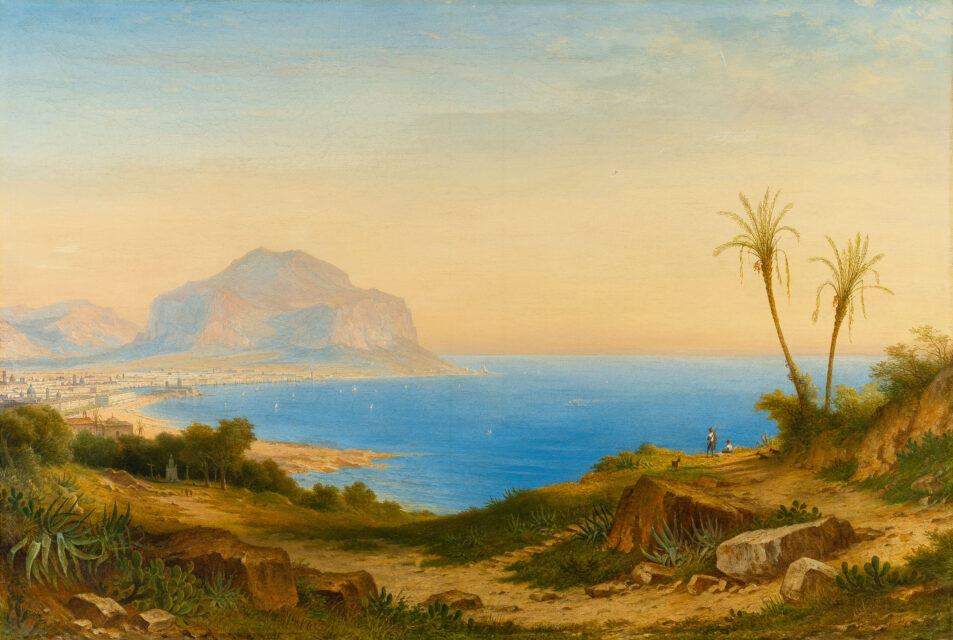View of Palermo with Monte Pellegrino in the background
Details
Provenienz:
1860 von Adolf Friedrich Graf Schack, München, bestellt;
Friedrich Nicolas Manskopf (1869-1928), Frankfurt am Main;
Privatbesitz, Frankfurt am Main;
J.P. Schneider jr., Frankfurt am Main, auf dem Keilrahmen mit Galeriestempel, 1992;
Privatbesitz, Frankfurt am Main;
Privatbesitz, Mecklenburg-Vorpommern.
Descrizione
In 1862, when our painting was created, Carl Morgenstern, the most important painter of a family of artists who had been successful in Frankfurt for generations, had been in Italy for almost thirty years. Following his initial training in his father’s studio, Morgenstern came to Munich in 1832, where he was supported by Carl Rottmann and his cousin Christian Bernhard Morgenstern and set off for Rome in the autumn of 1834. The visits to Rome, Tivoli, Naples, a stay of several weeks on Capri and the Amalfitana were followed by a trip to Sicily in the autumn of 1835, which Morgenstern soberly summarized: “We drew the most interesting things; apart from the 3 points of Taormina, Palermo & Cefalù, I found nothing of scenic interest,” he wrote to his parents on November 23, 1835, not without mentioning that the interior of Sicily was very “boring.” It was above all the panoramic views with the characteristic motifs in the distance that could be seen at the three places mentioned which appealed to Morgenstern. He recorded the three locations in precisely executed drawings and in numerous small-format oil studies created in plein air. He mostly painted Palermo from Capo Zafferano in the east with a view over the Gulf of Palermo and Monte Pellegrino, the landmark and local mountain of Palermo. Goethe had already sung the praises of the bare rock, attesting to it a beauty which could not be expressed in words. This painting shows the same view of Monte Pellegrino, on the elevated, rocky coastline dotted with agaves and bushes, in the right foreground we see two shepherds immersed in contemplation of nature under two palm trees. Below, the city spreads out to the left, vaguely hinted at and overlooked by the massif of Monte Pellegrino, which rises above the sea in the morning haze. It is a view that had fascinated the Romantics: Morgenstern’s teacher Rottmann painted a very similar view and it was he who inspired him to study nature without fail, but it was only Morgenstern’s own experience of Italy and the southern light that allowed him to develop his own visual language. Morgenstern truly invented himself as a painter in Italy – the play of summer light and the colours of the south became his trademark, which he retained even after his return to Frankfurt. Morgenstern’s view of Palermo was a highly successful motif – several versions are known to exist today. In addition to small oil studies painted en plein air in 1835, he did not lose sight of the motif even after his return to Frankfurt – a view was created in 1848, another commissioned in 1856 by Wilhelm Rohmer from Frankfurt, then another, and finally this painting – the last – in 1862. The work was ordered by the Munich art patron and collector Adolf Friedrich Graf Schack. Schack met the painter, whom he admired for his ability to capture “the blue scent of the distance, resting on the banks and the sea”, in 1860 and ordered a total of five paintings from him. Among them was the present view of Palermo, which Schack did not include in his gallery, which is why Morgenstern sold it shortly afterwards to the Frankfurt wine dealer Nicolas Manskopf. Dr. Peter Prange
* Tutte le informazioni includono la commissione a carico dell'acquirente (27%) senza IVA e senza garanzia. Salvo errori.
** Tutte le informazioni più la commissione a carico dell'acquirente e l'IVA e senza garanzia. Salvo errori.
*** Con riserva: L'offerta è stata accettata al di sotto del limite. L'acquisizione dell'opera potrebbe essere ancora possibile nella nostra vendita post-asta.
R = Le opere d'arte regolarmente tassate
N = Opere d'arte soggette a tassazione differenziata e provenienti da un paese non UE
Non è consentita la riproduzione e la distribuzione privata o commerciale di tutte le illustrazioni delle opere esposte nell'archivio della mostra e dell'asta. Tutti i diritti riservati.


